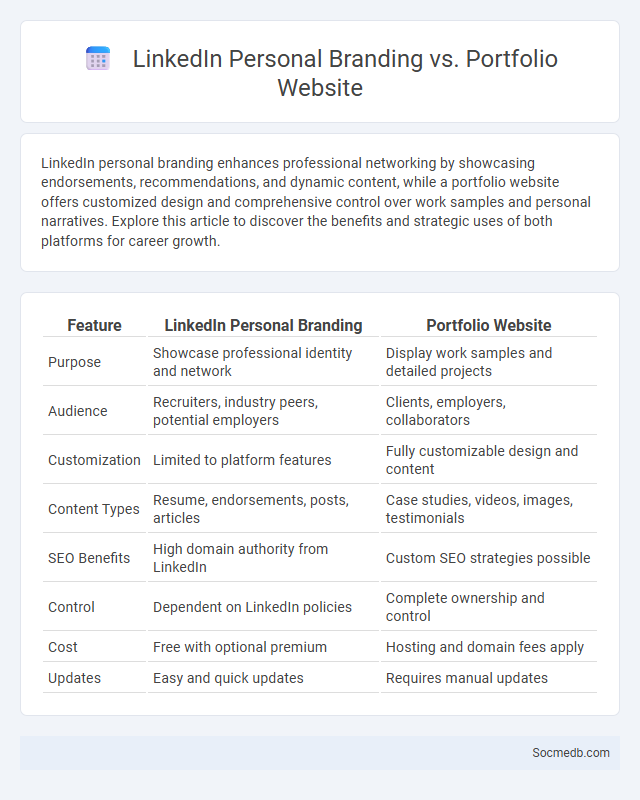
Photo illustration: LinkedIn Personal Branding vs Portfolio Website
LinkedIn personal branding enhances professional networking by showcasing endorsements, recommendations, and dynamic content, while a portfolio website offers customized design and comprehensive control over work samples and personal narratives. Explore this article to discover the benefits and strategic uses of both platforms for career growth.
Table of Comparison
| Feature | LinkedIn Personal Branding | Portfolio Website |
|---|---|---|
| Purpose | Showcase professional identity and network | Display work samples and detailed projects |
| Audience | Recruiters, industry peers, potential employers | Clients, employers, collaborators |
| Customization | Limited to platform features | Fully customizable design and content |
| Content Types | Resume, endorsements, posts, articles | Case studies, videos, images, testimonials |
| SEO Benefits | High domain authority from LinkedIn | Custom SEO strategies possible |
| Control | Dependent on LinkedIn policies | Complete ownership and control |
| Cost | Free with optional premium | Hosting and domain fees apply |
| Updates | Easy and quick updates | Requires manual updates |
Understanding LinkedIn Personal Branding
LinkedIn personal branding involves crafting a professional identity that highlights skills, experiences, and accomplishments to attract career opportunities. Consistently sharing industry-relevant content and engaging with connections builds credibility and reinforces expertise on the platform. Optimizing the LinkedIn profile with a clear headline, detailed summary, and measurable achievements increases visibility in search results and enhances networking potential.
The Power of a Portfolio Website
A portfolio website serves as a dynamic digital hub for showcasing social media expertise, highlighting curated content, and demonstrating successful campaign results. It enhances personal branding by providing a centralized, professional platform that attracts potential clients and employers through engaging visuals and authentic storytelling. Leveraging SEO strategies on a portfolio site significantly increases online visibility, driving organic traffic and expanding influence within competitive social media landscapes.
Defining Personal Branding in the Digital Era
Personal branding in the digital era involves strategically shaping your online identity to reflect your expertise, values, and unique personality across social media platforms. It focuses on consistent content creation, engagement, and visual design to build credibility and recognition among your target audience. Mastering this process empowers your career growth and expands professional opportunities through a strong digital presence.
Key Differences: LinkedIn vs Portfolio Website
LinkedIn functions as a professional social networking platform emphasizing connections, endorsements, and job opportunities, while a portfolio website offers complete control over showcasing work samples and personal branding. LinkedIn's structured format includes profiles, recommendations, and activity feeds tailored for recruitment algorithms, whereas portfolio websites enable customized design, multimedia integration, and detailed project descriptions. Both platforms serve crucial roles in professional identity, but portfolio websites provide deeper creativity and personalization beyond LinkedIn's standardized profiles.
Pros and Cons of LinkedIn for Personal Branding
LinkedIn offers powerful tools for personal branding by enabling you to showcase your professional achievements, expand your network, and access industry-specific content that boosts your credibility. However, the platform's competitive environment can make standing out challenging, and maintaining an active, consistent presence demands significant time and effort. Your personal brand benefits most when you strategically leverage LinkedIn's features to highlight your unique skills while navigating its demands effectively.
Advantages and Limitations of Portfolio Websites
Portfolio websites offer a powerful platform for showcasing your skills, projects, and professional achievements in a visually engaging and easily accessible format, enhancing your online presence and credibility. They allow you to control the narrative around your personal or professional brand without relying on the algorithms and changing policies of social media platforms. However, portfolio websites require ongoing maintenance, strong web design skills, and may attract less organic traffic compared to the viral potential and community engagement offered by social media channels.
Building Your Unique Personal Brand Online
Building your unique personal brand online requires consistent content creation that highlights your expertise, values, and personality across platforms like LinkedIn, Instagram, and Twitter. Leveraging targeted keywords and authentic storytelling enhances your visibility in search results and fosters deeper audience engagement. Regularly analyzing performance metrics allows you to refine your strategy and strengthen your digital presence effectively.
Integrating LinkedIn and Portfolio Website Strategies
Integrating LinkedIn with Your portfolio website amplifies professional visibility by creating a seamless connection between curated work samples and your verified credentials. Leveraging LinkedIn's networking tools alongside your portfolio's detailed project showcases drives targeted traffic and builds trust with potential clients or employers. Optimizing both platforms with consistent keywords and up-to-date information maximizes search engine ranking and enhances personal brand authority.
Choosing the Right Platform for Your Brand Goals
Selecting the ideal social media platform depends on your brand's target audience, content style, and marketing objectives to maximize engagement and conversions. Instagram and TikTok are highly effective for visually-driven brands targeting younger demographics, while LinkedIn suits B2B companies aiming for professional networking and lead generation. Analyzing platform user demographics and content compatibility ensures strategic alignment with your brand's goals and optimizes return on investment.
Tips for Maximizing Your Personal Brand Impact
Consistently share high-quality content showcasing your expertise and unique personality to strengthen your personal brand on social media. Engage actively with your audience by responding to comments and participating in relevant conversations to build trust and expand your reach. Optimize your profiles with clear visuals, keywords, and links to professional sites to attract the right opportunities for your growth.
 socmedb.com
socmedb.com